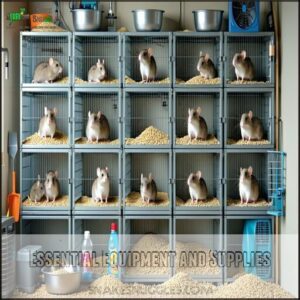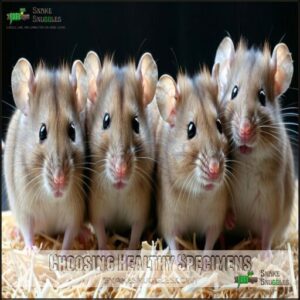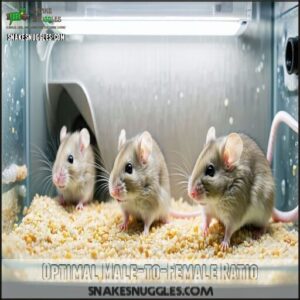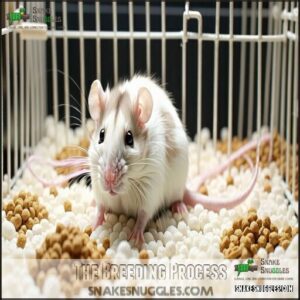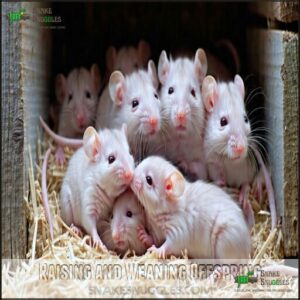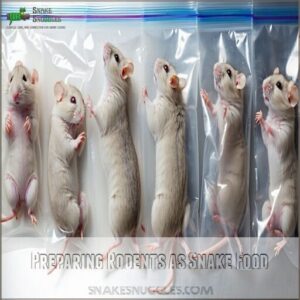This site is supported by our readers. We may earn a commission, at no cost to you, if you purchase through links.

Start with sturdy cages or bins, plenty of ventilation, and soft bedding like aspen shavings. Keep males and females separate until breeding—otherwise, you’ll have more babies than you bargained for!
Aim for one male per two or three females to avoid overcrowding. Pregnant females need high-protein food and quiet spaces.
Once the pups arrive, monitor them for health and wean them at 3-4 weeks. When it’s time to prepare them for your snakes, guarantee humane handling and size-appropriate options.
Set it up right, and you’re golden! With proper care, including quiet spaces, you can successfully breed rats and mice for snake food.
Table Of Contents
- Key Takeaways
- Setting Up Your Breeding Colony
- Selecting and Managing Breeding Pairs
- The Breeding Process
- Raising and Weaning Offspring
- Preparing Rodents as Snake Food
- Frequently Asked Questions (FAQs)
- Can you breed mice for snake food?
- What are the rules for breeding mice?
- How to set up rat breeding?
- Is breeding mice worth it?
- What is the best temperature for breeding rats?
- What is the Best Way to Feed a Snake?
- Are There Any Risks Associated With Feeding a Live Rodent to a Snake?
- What is the Ideal Ratio of Females to Males for Breeding Rodents?
- How Often Should the Enclosure Substrate Be Changed?
- What is the Average Lifespan of a Rat?
- Conclusion
Key Takeaways
- Set up secure, well-ventilated enclosures with proper bedding and maintain a clean environment to keep your rodents healthy.
- Separate genders early to avoid overcrowding and maintain a 1:3 or 1:4 male-to-female ratio for balanced and productive breeding.
- Provide pregnant females with a high-protein diet, quiet spaces, and nesting materials for healthy pregnancies and stress-free litters.
- Use humane euthanasia methods like CO2 chambers and ensure proper storage to maintain the quality of rodents as snake food.
Setting Up Your Breeding Colony
Setting up your breeding colony starts with choosing sturdy, escape-proof enclosures and gathering the right supplies like bedding, food, and water bottles.
Sturdy enclosures, cozy bedding, and essential supplies turn your breeding colony into a healthy, thriving hub for rodents.
Make sure the environment is clean, well-ventilated, and kept at the right temperature to keep your rodents healthy and productive.
Choosing Appropriate Housing
Setting up the perfect rodent breeding setup starts with choosing the right housing. You’ll need enclosures that are secure, spacious, and well-ventilated to keep your rats or mice healthy and happy.
Here’s what to focus on:
- Enclosure Size: At least 1-2 sq ft per pair for comfort.
- Ventilation Needs: Drill small holes or use mesh lids for airflow.
- Bedding Types: Paper pellets work best for cleanliness and odor control.
- Sterilization Methods: Clean cages weekly with a bleach solution.
- Location Considerations: Keep cages in a quiet, warm room away from predators.
Consider specialized rodent housing options for ideal breeding. Happy rodents make breeding a breeze!
Essential Equipment and Supplies
A successful rodent breeding setup starts with the right breeding supplies.
Use durable Housing Materials like escape-proof cages or storage tubs. Bedding Options, such as paper pellets or aspen shavings, keep enclosures clean and cozy. Feeding Tools—sturdy bowls and drip-free water bottles—are essential for daily nutrition. Cleaning Supplies, like disinfectants and scrub brushes, make hygiene a breeze. For colder climates, Heating Systems maintain a stable environment.
Remember that proper ventilation is vital to maintain healthy conditions.
| Essential Item | Purpose | Pro Tip |
|---|---|---|
| Escape-proof cages | Safe housing | Check for chew-proof materials. |
| Paper pellet bedding | Cleanliness and comfort | Replace weekly to reduce odors. |
| Water bottles | Hydration | Pick leak-proof designs. |
| Food bowls | Nutrition | Use heavy bowls to prevent tipping. |
| Cleaning supplies | Hygiene | Sterilize weekly for rodent health. |
Investing in quality gear guarantees your rat breeding or mouse breeding colony thrives!
Creating a Suitable Environment
Creating the perfect environment for your rodents isn’t just about housing—it’s about getting every detail right. Start with proper temperature control; aim for 70-80°F to keep them comfortable. Don’t forget humidity levels—stick to 30-50% to avoid health problems. Good air circulation matters too, so address ventilation needs by drilling small holes in enclosure lids or using mesh tops.
Keep your rodents comfy with a warm 70-80°F, 30-50% humidity, and excellent ventilation for health and happiness!
Ensuring proper thermal regulation products is essential for maintaining a healthy rodent colony.
For bedding, choose wisely. Bedding types like aspen shavings or paper pellets are soft, absorbent, and help with odor control.
Follow these steps for a thriving colony:
- Sterilize enclosures regularly to maintain hygiene.
- Use bedding that supports respiratory health.
- Keep enclosures away from predators.
- Monitor and adjust temperature and humidity as needed.
Selecting and Managing Breeding Pairs
Choosing the right breeding pairs is key to keeping your colony healthy and productive.
You’ll need to focus on selecting disease-free animals, separating genders early, and maintaining a balanced male-to-female ratio for smooth operations.
Choosing Healthy Specimens
Picking healthy rodents is your first step to strong, disease-resistant litters. Look for bright eyes, sleek coats, and active behavior—these physical traits signal exceptional rat health and mouse health.
Avoid inbreeding by tracking rat genetics and mouse genetics, ensuring genetic diversity. Behavioral cues like energy levels also hint at overall well-being.
Always source breeders from reputable suppliers to minimize risks of illness or parasites. A premium diet is non-negotiable—it boosts disease resistance and supports robust offspring.
Healthy breeders mean thriving litters and a safer, high-quality food supply for your snakes. It’s a win-win for everyone involved, ensuring strong and disease-resistant litters.
Proper Gender Separation
At around four weeks, it’s time for gender separation to keep breeding rats and mice under control.
Spot males by their visible testicles and females by their belly nipples—quick and straightforward gender identification.
Separating them prevents unplanned litters and avoids littermate breeding, which can lead to genetic issues.
Stick to this routine at weaning age to maintain population control.
A little effort here keeps your male-to-female ratio balanced and sets the stage for healthy breeding pairs later.
Responsible breeders also prioritize transparency about genetic risks to guarantee the health of future generations.
Optimal Male-to-Female Ratio
Keeping the right male-to-female ratio is like setting up a well-balanced team.
The ideal ratio is one male for every three to four females, ensuring smooth operations and happy rodents.
This setup boosts productivity maximization while avoiding overcrowding and stress.
Too many males? You’ll see fights. Too few? Breeding slows down.
Proper gender separation is key to maintaining harmony and healthy breeding pairs.
Plus, rotating males occasionally can improve genetic diversity.
Think of it as smart resource allocation—you’re managing space, food, and energy while keeping your colony’s breeding frequency steady and thriving.
The Breeding Process
Getting your rats and mice to breed successfully starts with pairing them in a calm, neutral space.
Once mating happens, you’ll need to watch for pregnancy signs like swelling and increased appetite to confirm everything’s on track, which is crucial for a successful breeding process with increased appetite.
Mating Techniques
Introduce breeding pairs in a neutral space for 24-48 hours to encourage natural mating habits.
Rotate males among females to maintain genetic diversity and optimize fertility. Watch for receptivity signs, like females turning their rear toward males, and confirm a proper male-to-female ratio (1:3 or 1:4).
- Tip: Confirm successful mating by checking for a “plug” at the female’s rear end.
Mastering these breeding techniques guarantees smooth cycles and healthy offspring, making your rodent colony productive and stress-free.
Gestation and Pregnancy Signs
How can you tell if a rat or mouse is pregnant? Look for pregnancy signs like abdominal swelling, visible nipple growth, and increased appetite.
Mouse gestation lasts 19–21 days, while rat pregnancy takes 21–23 days. Expect litter sizes of 6–20 pups.
Watch for nest building, a clear indicator of labor approaching. False pregnancies are rare but possible, so stay observant!
Caring for Pregnant Females
When your female rat or mouse shows pregnancy signs, it’s time to shift gears and focus on her comfort and care. A smooth gestation depends on meeting her dietary needs and keeping stress levels low.
Think of her as the queen of her little kingdom—she needs a cozy setup and plenty of attention. Provide high-protein snacks like boiled eggs or nuts, and stock up on nesting materials such as shredded paper. These help with litter care and keep her calm.
Avoid loud noises or excessive handling to reduce stress. Keep an eye on her for swelling or unusual behavior. Separate her from males to prevent unnecessary stress and aggression.
- Offer high-protein treats.
- Provide soft, absorbent bedding.
- Monitor her health daily.
- Create a quiet, low-stress environment.
- Prepare for postpartum care and offspring health.
Raising and Weaning Offspring
When raising newborn rats or mice, you’ll need to monitor their health closely and make certain they’re nursing properly.
As they grow, provide a high-protein diet and separate them from the mother at the right time to prevent overcrowding.
Monitoring Newborns
How do you guarantee strong offspring health? Start with attentive neonatal care.
Watch for these signs:
- Birth Defects—check for irregularities in appearance.
- Feeding Patterns—consistent nursing shows mom’s doing well.
- Behavioral Cues—lethargy signals trouble.
Weigh pups regularly to track growth. Early intervention saves struggling newborns.
Keep handling minimal—stress disrupts litter care. Let mom work her magic while you focus on weaning-ready pups.
Proper Nutrition for Growth
Healthy growth starts with a solid rodent diet. Feed your rodents high-protein sources like premium rodent blocks or lab chow to support development.
Add dietary variety with fresh veggies, grains, and occasional nuts, but skip anything processed. For balanced rodent nutrition, include vitamin supplements and guarantee proper mineral balance.
Consider quality rodent lab chow for peak health. Hydration needs are just as important—always provide clean water.
Nutritious meals lead to stronger, healthier rodents, making them ideal snake food. Remember, a premium diet isn’t just a luxury; it’s the backbone of successful breeding.
Separating Young From Parents
Once your rodent litters are thriving, it’s time to focus on weaning age—typically three to four weeks—to guarantee healthy growth and avoid overcrowding.
Move the young mice or rats into separate cages, giving them space to thrive and preventing unintended breeding. Keep an eye on their progress; steady weight gain and solid food consumption signal readiness for rat separation or mouse litters relocation.
Here’s how to make it smooth:
- Monitor growth: Check weight daily to spot slow developers.
- Hand-feed pups: Support weaker ones with extra care.
- Gender separation: Separate males and females to prevent early breeding.
- Breeder rotation: Organize groups for future breeding.
- Overcrowding prevention: Use spacious cages to minimize stress.
Thoughtful planning now guarantees robust rodents later!
Preparing Rodents as Snake Food
To prepare rodents as snake food, you’ll need to handle them safely and follow proper euthanasia methods to guarantee humane treatment.
By storing and sizing them correctly, you can provide your snake with a healthy and suitable meal.
Humane Euthanasia Methods
Now that your rodent colony is thriving, it’s time to think about humane euthanasia methods. CO2 euthanasia is the gold standard—quick, stress-free, and aligned with ethical practices.
Invest in a proper CO2 chamber; never improvise with random setups. If you’re skilled, alternative methods like cervical dislocation can work but require precision to prevent suffering.
Compassionate euthanizing isn’t just about your rodents; it helps protect your snake’s health too. Understanding the importance of maintaining colony health makes a consistent supply of feeders.
- Avoid freezing rodents alive—it’s inhumane due to prolonged suffering.
- Stick to ethical considerations, maintaining control and reducing stress for both animals and yourself during the humane dispatch process.
Proper Storage and Handling
Proper storage and handling of frozen rodents keep them fresh and safe for your snakes.
Prevent freezer burn by packing each rodent individually in airtight containers. Gloves are your best friend—use them to maintain hygiene practices and avoid rodent contamination.
Keep your freezer organized; nobody wants to dig for a feeder like it’s a treasure hunt.
For thawing, place frozen rodents in a ventilated container in the fridge to avoid contamination. Always clean surfaces thoroughly after handling. A little safe handling goes a long way in ensuring your feeders remain top-quality for your snakes, and it’s crucial to maintain good hygiene practices and prevent freezer burn.
Matching Prey Size to Snake Size
In regards to snake feeding, size does matter! Use this Prey Size Guide for happy, healthy snakes:
- Measure your snake’s mid-body width (string tricks work if you’re without tools).
- Choose feeder rodents no bigger than 1.5 times that width.
- Follow rodent sizing charts to avoid overfeeding risks or undersized prey.
- Gradually adjust prey size as your snake grows.
Matching prey size helps avoid injuries and makes certain proper digestion—your snake will thrive with the right-sized meal!
Frequently Asked Questions (FAQs)
Can you breed mice for snake food?
You absolutely can breed mice for snake food.
Set up escape-proof enclosures, maintain proper temperature and humidity, and separate males and females early.
Provide a high-protein diet for strong, healthy offspring perfect for feeding, ensuring they are perfect for the intended purpose.
What are the rules for breeding mice?
Start by selecting healthy mice with diverse genetics.
Keep males with 2-3 females, separating them after 24 hours of pairing.
Provide nesting material, a balanced diet, and monitor for signs of pregnancy like nesting or swelling.
How to set up rat breeding?
Think setting up a rat breeding colony is overwhelming? It’s not!
Use escape-proof cages, aspen bedding, and stable temps (72°F).
Ventilate well, sterilize frequently, and keep rats in a separate room from predators.
Is breeding mice worth it?
Breeding mice can be worth it if you’ve got snakes to feed or need a steady supply.
It takes effort—cleaning, feeding, and monitoring—but it saves money long-term and gives control over health and size.
What is the best temperature for breeding rats?
You’ll want to keep the temperature between 70-80°F.
This range promotes healthy breeding and comfort.
Avoid extremes—too hot, they’ll stress out; too cold, they’ll slow down on reproducing.
A cozy middle ground works best!
What is the Best Way to Feed a Snake?
Providing dinner for your snake is all about matching prey size to the middle of its body.
Use healthy, thawed frozen rodents, avoiding anything wounded or sick, and watch your snake thrive.
Are There Any Risks Associated With Feeding a Live Rodent to a Snake?
Feeding live rodents can be risky.
Rodents may bite or injure your snake, potentially causing infections or stress.
It’s safer to use pre-killed or frozen rodents, protecting both your snake’s health and your own peace of mind.
What is the Ideal Ratio of Females to Males for Breeding Rodents?
Aim for a 1:3 or 1:4 male-to-female ratio. This balance keeps productivity up while preventing overcrowding. Too many males together lead to fights, so stick with one dominant male per breeding group.
How Often Should the Enclosure Substrate Be Changed?
Change the substrate every 3-7 days, depending on cage size and odor.
A nose test works wonders—if it smells, it’s time!
Frequent cleaning keeps your rodents healthy and guarantees a cleaner environment for breeding.
What is the Average Lifespan of a Rat?
Think of rats as sprinters, not marathon runners.
They usually live 2-3 years, though excellent care might stretch that.
It’s short but sweet—like a Netflix binge, their time flies by quickly!
Conclusion
Think you’re ready to get started with breeding rats and mice for snake food?
It’s simpler than it seems when you plan carefully. Start with sturdy housing, manage your breeding pairs smartly, and keep pregnant females well-fed and stress-free.
Monitor the pups, wean them properly, and guarantee humane handling when prepping them as prey.
By following these steps, you’ll create a reliable setup to meet your snake’s needs, saving time and money while guaranteeing your colony thrives.
- https://community.morphmarket.com/t/some-rodent-breeding-tips/25522
- https://thetyedyediguana.com/blog/keeping-rodents-for-your-snakes/
- https://www.reddit.com/r/reptiles/comments/zq4njy/trying_to_breed_mice_to_feed_my_snake_and/
- https://www.reptileforums.co.uk/threads/breeding-your-own-mice-rats-as-snake-food.966793/
- https://www.visionproducts.us/blog/mice-breeding-pros-and-cons/?srsltid=AfmBOoqgMBo1lmfPrZHXagEVdahTcgUbeDsC96ZYOBjP3rOSa-5hmdBv


